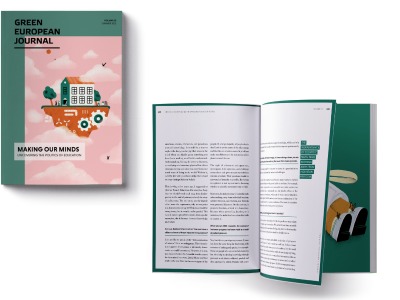Life in Via dell’Archeologia in Tor Bella Monaca on the outskirts of Rome is marked by institutional disinterest and the autarchic microcosm that is the neighbourhood’s underground economy. For years, the local school was plagued by high dropout rates and difficult teaching conditions. But the arrival of new leadership showed a different way of teaching, capable of defusing local tensions and reactivating social mobility. The experience stands out as a reminder of how schooling is at once a cause of and a potential answer to Europe’s spatial inequalities.
It took three hours to clean the window. Three hours to remove the encrustation of 20 years of neglect that had built up between the bars and the opaque glass.
After three years and sixteen shopping trolleys full of discarded books, the messy old room with its dirty windows has finally returned to life as a school library. Now the books are catalogued. From its windows, you can see the towering rows of social housing that stand out on Via dell’Archeologia in Tor Bella Monaca.
Located in the east of Rome on the far side of the Grande Raccordo Anulare ring road, Tor Bella Monaca is one of Europe’s many peri-urban spaces that exist as enclaves of inequality. Built on land occupied illegally during Italy’s post-war construction frenzy, today it is a strip of land into which the tentacles of the urban economy still reach but the where attention and resources of city government are diluted, if not absent.
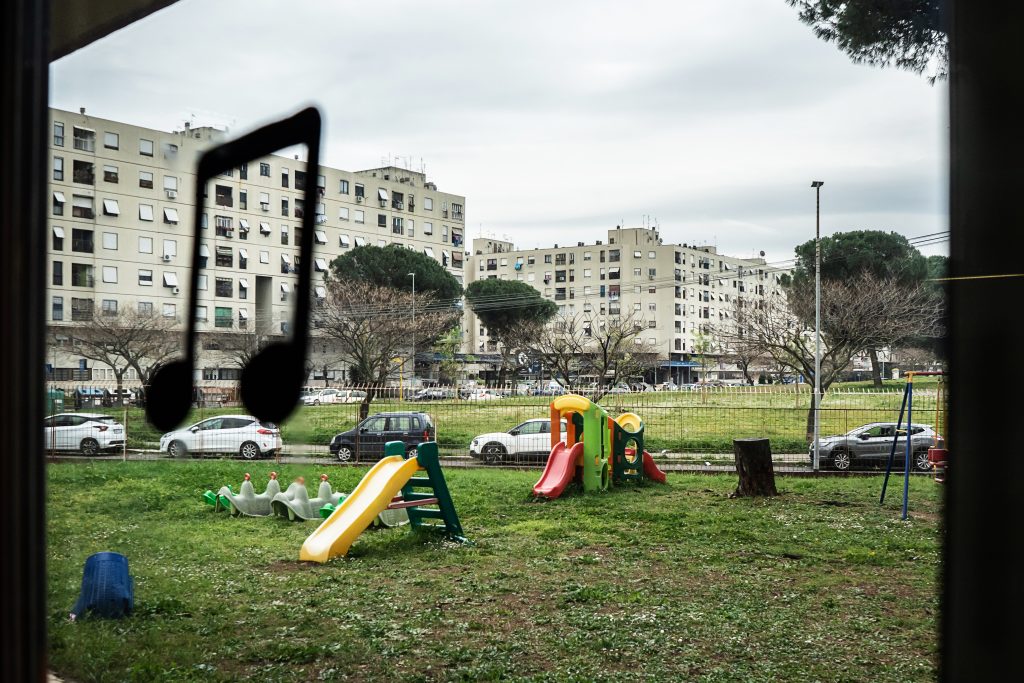
The cluttered concrete of public housing represents 82 per cent of residential buildings in the neighbourhood, the highest density in Italy. The area is well known for criminality linked to drug trafficking. On Via dell’Archeologia, the main street for dealing, it is estimated that drug profits reach around 600,000 euros a month. This thriving clandestine economy meets the needs of a neighbourhood lacking other options, with unemployment rates much higher than the capital’s average.
The only institutional centre in the triangular space formed by the two parts of Via dell’Archeologia is the Istituto Comprensivo “Melissa Bassi”, a complex of colourful buildings with a poorly maintained garden and a small library with recently cleaned windows.
Currently, the school has 720 children – spanning early years, primary, and lower secondary – most of whom are from the neighbourhood. They are the youth of Via dell’Archeologia, an area where there are more children than adults. Their restless life invades the school environment. Between the rows of multi-storey tower blocks, school and children share a destiny intertwined with the dynamics of the neighbourhood.

The closed road
Tor Bella Monaca is characterised by irregular streets and a built environment that rises upwards in tower blocks. Less than two kilometres from the Melissa Bassi Institute, there is a large, squat structure with a colonnade at the entrance: the Liceo Scientifico Linguistico Amaldi. A high school considered to be one of the best secondary schools in the Lazio region, despite its location.
Emiliano Sbaraglia, who teaches literature at Melissa Bassi, experienced the quality of teaching at Amaldi first-hand during his years as a supply teacher: “The difference is big, especially in terms of preparation and from a didactic point of view. It annoys me to think that there’s not even a couple of kilometres between us. Why do things work there and not here?” He is a middle-aged man with fingers covered in large rings and a grizzled head; a calm figure who has become a reference point for many at the school.
“Our students who go there are treated as if they are going to fail because they don’t have the necessary basic skills. We try to fight this prejudice, but it’s also partly true,” explains Emiliano as his car rolls along the row of whitish apartment blocks of Via dell’Archeologia.
“Here’s why: it’s this road.”
In Tor Bella Monaca, public and private urban planning are subservient to the trafficking culture. The alcoves of buildings and hidden streets designed in the social housing boom of the 1980s now host a self-sufficient modular economy. Despite repeated raids, the lifts in drug-infested towers are blocked to use as warehouses for goods, while terraces remain strategic lookout points.
In the school car park, Emiliano traces the invisible border of this self-managed microcosm with his fingers: “Continuing towards the entrance to the motorway,” he explains, “there is the Rome-Naples connection that in two hours takes you to the heart of Italy’s drug trade, the Neapolitan district of Scampia.” A bridge that defines and shapes neighbourhood life.
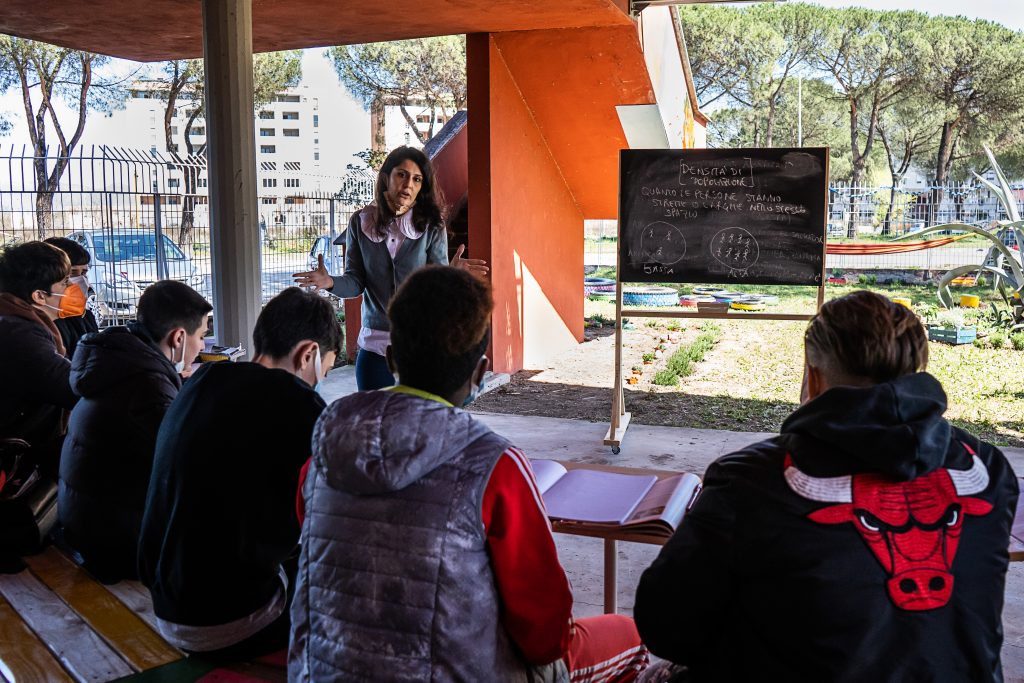
An open school
Teaching in institutions like Melissa Bassi can be a political choice. Before applying for the transfer, Emiliano had started as a teacher at a middle-class school in Frascati, a quiet town to the south of Rome. It was two hundred metres from the house where he was born and raised and next to the football pitch where he played as a centre forward.
“I asked for a transfer to come here. I chose this school because here, I feel useful.” Emiliano is not the only one to teach at Melissa Bassi by choice. This often makes the difference: “Until a few years ago I was very critical of teachers who, upon arrival, asked for a transfer. Then I realised that not everyone is inclined to teach in such a context.”
The institute has changed a lot since 2011 when Emiliano first joined Melissa Bassi with Save The Children to set up improvised radio studios in classrooms. The school suffered from years of temporary administration. There was no permanent headteacher and the role was filled by the heads of other institutions who often lacked the time or dedication to manage the complexities of such a school. “Many headteachers weren’t very present, and when they were, it was as if they weren’t there,” says Emiliano.
After several substitutes, in 2019 Alessandra Scamardella took on the post and gave the school and its faculty a new presence. Now her office door is open to everyone three days a week, including families.
“The stability given by the new management and some new educational approaches rebuilt the area’s confidence in the educational institution,” Alessandra explains. “Here, parents must be supported, invited, called: the formula of the virtual open day doesn’t work like in other schools… We are perpetually behind schedule and parents must be chased up. That’s why we also try to involve them, for example, in computer literacy programmes.”
The school touches all areas of public life in the area, and so the new impulse brought together institutions, local bodies, and the community. For the first time in years, a different relationship between public bodies and the community was put forward for the generally overlooked neighbourhood.
“In collaboration with the Fondazione Paolo Bulgari [a philanthropic foundation focused on poverty and educational inequality], we are organising a social support centre that operates at least once a month to ensure synergy between public institutions and associations,” explains principal Scamardella. These initiatives also arise out of the need to help the local community out of its isolation and help people discover the world that exists beyond the limits of Via dell’Archeologia.
Even the interiors of Melissa Bassi have changed their appearance to accommodate new dynamics and teaching models. Spaces lost over the years are being recovered under the guidance of the new administration. Some rooms were previously cluttered with rubbish and old furniture, while others became personal spaces. The institute is immense. It has large classrooms and murky hidden areas that had been abandoned in the careless succession of substitute administrators and a climate of general indifference.
“There were some unknown rooms, locked, maybe because the janitor had taken over the space. How can you get away with occupying public spaces?” asks Marco Fusco, head of art and drawing, while he sits in the new art workshop set up with the help of the students. It is a recently renovated classroom space, in a room with blue walls and yellow radiators that is now full of sketches and drawings.
Like the art room, today many spaces have been reclaimed for the school and community. Until a few years ago, even what is now the large teachers’ room, with painted walls and a view of the inner courtyard, was a carpentry shop. In the meantime, a street art workshop has been set up in another space under the care of the ColorOnda social project. Next door, a classroom is given over to the Museo delle Periferie (Museum of the Outskirts). Yet another became the music laboratory.
As if asserting its place in the autarchic system that is Via dell’Archeologia, the school repaints its walls, builds convivial spaces, and weaves ties with the local community. Altogether, it is creating a space that can offer an alternative existence for the area. But beyond its walls, life on the hard concrete forces another, harsher sense of belonging on the students.
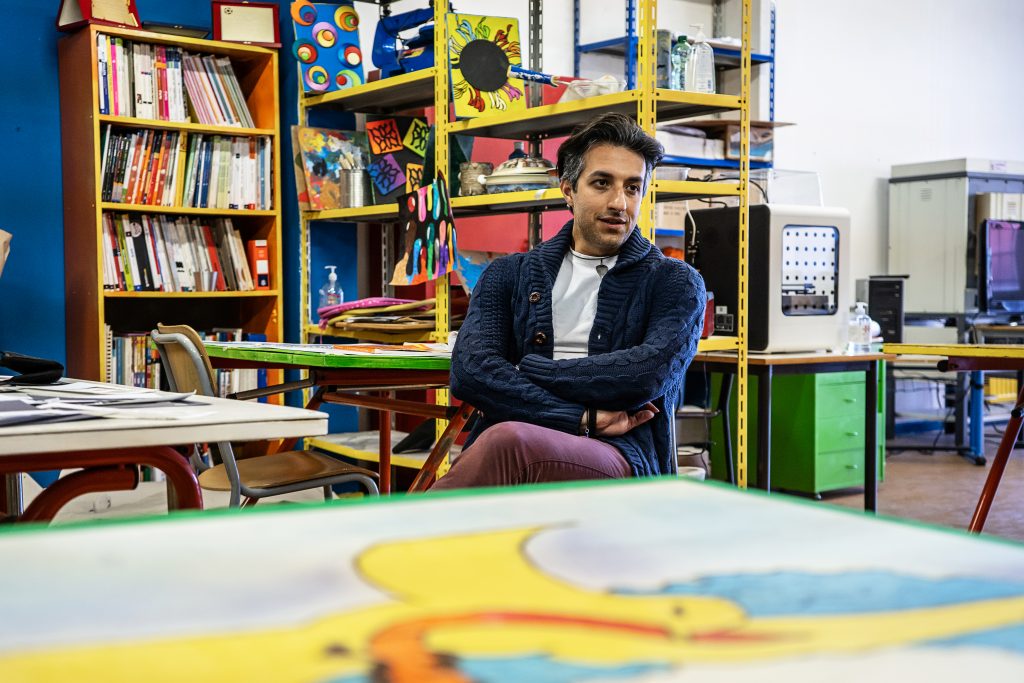
Neighbourhood legacies
Maira [name changed] has not been seen at school since she turned 17 last January. You can find her across the road in the desolation of the empty spaces between buildings and in the half-light of the bottlenecks that run through them.
Maira’s path has been determined by a neighbourhood life beyond her control. She was left wandering from house to house alone while her parents were in jail, only for her to be removed from the custody of her grandfather after a check-up by social services. “What can you do… You can hardly blame Maira?” Emiliano asks himself.
Emiliano has been chasing Maira through the labyrinths of Via dell’Archeologia for at least three years. Maira is only halfway down the list. The class Emiliano teaches is a faithful reproduction of statistics: “We are among the worst in Italy for early school leavers. The average at Melissa Bassi is 19 per cent, compared to the European average of 10 per cent and the national average of 13 per cent. Four out of eighteen students dropped out, a perfect average. In eight years, there have been too many.” In the face of the lingering school losses, today a group of teachers offers support to students at risk of dropping out, working in cooperation with regional health units and social services.
But the early school leavers of Melissa Bassi are not isolated cases: they are snapshots that recall the data of certain rural schools in France or the social segregation of the Parisian banlieue, where a centralised education system has produced a gulf in teaching quality and resources between the outskirts and rich neighbourhoods, between countryside and city. The result is an education system split in two, which fails in its role as a social elevator and condemns new generations based on where they come from.
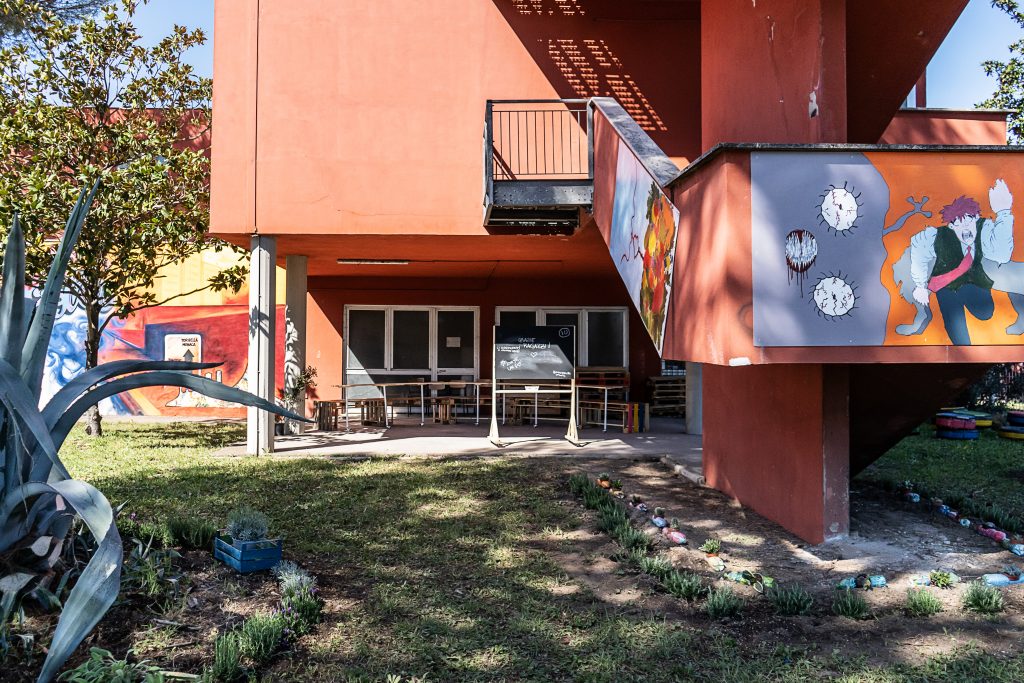
Around the world, spatial disparities undermine the social and economic hopes of entire generations. In London, the index of social mobility is among the highest in England. Meanwhile, the English countryside, the rugged coastlines, and the old industrial centres are paralysed: only 10 per cent of young people from disadvantaged backgrounds in the southern coastal towns of Hastings and Eastbourne go to university, compared with 50 per cent in London’s upmarket neighbourhoods of Chelsea and Kensington.
Education should be one of the main drivers of redistribution, especially primary and secondary education. But as is often the case, the neighbourhoods that need it most are also those where the quality teaching and school services are lacking. For many, the first inequality is access to quality education. In Tor Bella Monaca, the hope is that schooling can prevent the heavy territorial heritage from dragging new generations down.
“How can these young people be convinced? In the days of the temporary administration, I would pick them up on the street and tell them to go back to school because they had not been seen for maybe two weeks, but they would reply, “If even the principal doesn’t go to school, why should I? I earn 150 Euros a day out here.” Left with nothing to say, I would go back to school,” says Emiliano. “But now I can say something because there is a different model in the school.”
Politically sidelined
In the succession of floors and corridors at Melissa Bassi, there is the impression of a school that is only half full. Walking through the library, Emiliano speaks of a haemorrhage of students: “In 2011, we had classes from section A up to E, all full. But with the years of substitute principals, the school started to live day by day and enrolments fell. If they dropped further, we would run the risk of being merged into another school complex. It would be a great loss because, here on Via dell’Archeologia, we are the only institutional stronghold.”
After years of falling enrolment, the change in management stemmed the losses and now student numbers are starting to increase. The difference was made at Melissa Bassi by a more active and select teaching staff that gave meaning to the teaching hours. While the role of teachers remains critical, it is the ability to adapt teaching methods to context – as well as greater access to resources and services – that makes education systems more equitable. These elements often lie beyond the competence of each school so flexibility should also be framed in a structured national approach –you cannot always rely on some sort of enlightened leadership.
Tor Bella Monaca is also a peripheral suburb in the sense of institutional politics. Although the neighbourhood is recognised as a “risk area” in terms of its educational needs, further centralisation into the institutional machine of education policy is not a good fit to the social rifts that many schools find themselves mending.
“At the national level, there is no real autonomy for the organisation of school administrative departments, a fundamental factor in managing aspects such as the appointment of senior personnel and the filling of administrative vacancies. Then there is the problem of the number of teachers per class, which often fails to take into consideration an institution’s specific situation. Bureaucracy, which is not always the problem and which in any case must be respected, imposes conditions that do not take into account the specific problems experienced by individual schools. Internal management doesn’t matter when things are imposed from the top down,” explains Scamardella.
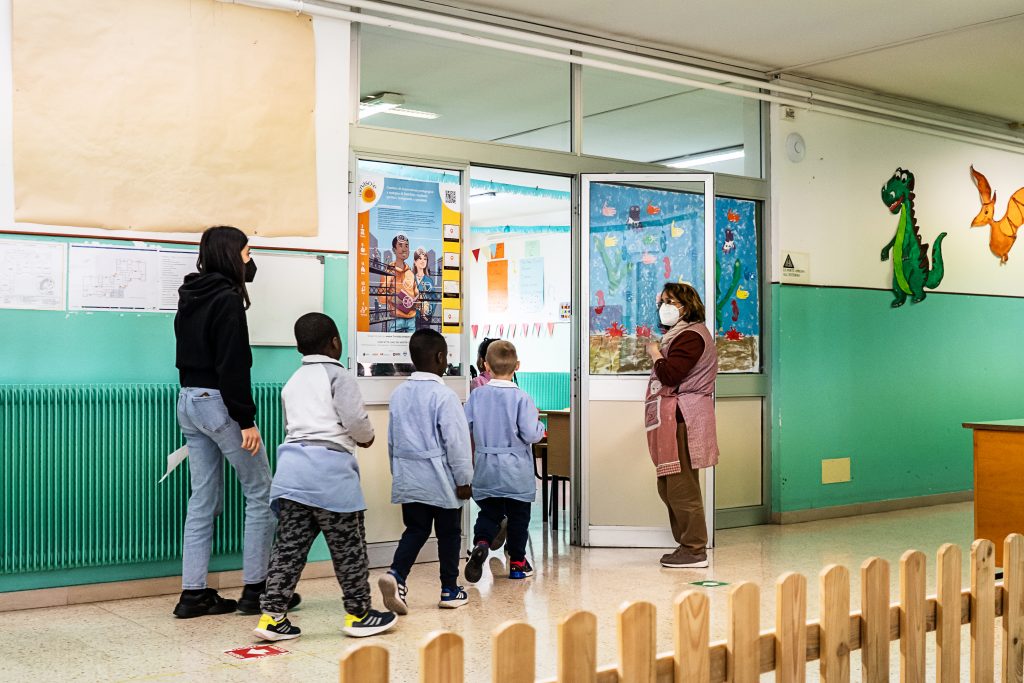
In the hands of proselytism
Emiliano is sitting between the benches in the library. “In eight years of teaching at this school, I have come to realise that I know nothing. You must live in the neighbourhood 24 hours a day to understand what it means to live here.”
In the library, a French door opens onto the courtyard of one of the school’s many secondary entrances. Emiliano hopes that one day, it can become the entrance to a new library for the local area. “If I know one thing, it’s that if you keep the school open in the afternoon, until five, it will help families and keep kids off the street.”
In Tor Bella Monaca, politics is often limited to the empty propaganda of election campaigns. The neighbourhood is the target for political and social proselytism that has often undermined the quality and effective meaning of politics and the solutions it could offer. As the neighbourhood remains on the fringes of political concerns, the real potential for transformation of the local environment remains untapped, leaving the security of Tor Bella Monaca in the hands of grassroots initiatives. “Have you seen how many green spaces there are? A lot could be achieved by investing in the environment and the area’s young people,” explains Emiliano.
In much of Europe, enclaves of inequality have become hotbeds of far-right populism. “The municipality is governed by Fratelli d’Italia. When the president was elected, in Via dell’Archeologia they celebrated with the Roman [straight-armed fascist] salute. To think that in the 1980s, this was one of the most communist neighbourhoods in Rome. What happened?” In places like Tor Bella Monaca, where economic deprivation prevails and public services have withered away, political polarisation and social conflict are generated by a neighbourhood life that no longer sees the benefits of politics and the collective social system.
Across the outskirts and neglected geographies of Europe, the same slow ritual of inequality is unfolding, driven by a generational failure of institutions and politics.
The efforts of the Melissa Bassi Institute in Tor Bella Monaca tell the story of the many schools operating on the frontline across Europe, down the vortex of inequalities where the centrifugal force of the educational system fights against the centripetal force of the neighbourhood. It might seem clear that education is central to building a fair society. But the institutions across Europe’s rural and urban peripheries require more resources, personnel, and autonomy than others, and these areas are the ones often most overlooked.
Despite limping institutional support, a driven teaching staff guided by a common vision allowed Melissa Bassi to show the potential of educational institutions operating in contexts of deep deprivation. It is not enough, but it is proof that guaranteeing access to quality education and long-term investment in neglected areas should be a priority for all who want to unhinge the spatial disparities afflicting Europe.
Photos by Federico Ambrosini. All rights reserved.

